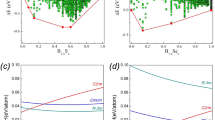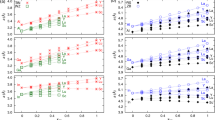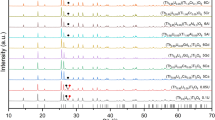Abstract
IN the course of a study on transition-element compounds of composition TB2 (T = transition element, B = phosphorus-group element) two compounds with a body-centred cubic structure were found, a semiconducting one in the system Re–As and a metallic one in the system Mo–Sb. Both compounds formed on reacting, at 600°–900° C, the powdered elements in various ratios. A crude analysis of ReAsx by thermal dissociation at 1,000° C gave x ≈ 2.4. Our arsenide, therefore, must be identical to the phase Re As2.3 reported by Wiechmann et al.1. The non-metallic behaviour as well as the diamagnetism of rhenium arsenide confirmed the suspected stoichiometry Re3As7 which corresponds to the normal valencies of Re and As. From density measurements, the unit cell [a = 8.722 ± 2 Å] was found to contain four formula units of Re3As7. Since in the X-ray diagram only the general extinctions for body-centred cubic symmetry are observed, seven space groups are possible. However, the striking resemblance between the diagram of Re3As7 and that of Ir3Ge7 led me to postulate a D8f structure for Re3As7. Best agreement between calculated and observed intensities was obtained for the following parameter values:  Assuming the D8f type to be correct* for Re3As7, the coordination is as follows:
Assuming the D8f type to be correct* for Re3As7, the coordination is as follows:  This proximity is, in fact, reasonable since it makes allowance for saturated covalent bonds as can readily be seen by invoking a charge transfer Re3+As3−As4 and by allowing half-bonds to form between Re and AsI. The non-metallic character of Re3As7 was established by resistivity measurements on sintered samples at temperatures above 300° C. Assuming ρ ≈ exp (δE/2kT), an energy gap δE ≈ 0.7 eV was derived. At room temperature the samples were n-type with a thermoelectric power of about 100 μV/°C. The magnetic susceptibility χM was found to be −210 and −250×10−6 cgs units/mole at liquid-nitrogen and room temperature, respectively.
This proximity is, in fact, reasonable since it makes allowance for saturated covalent bonds as can readily be seen by invoking a charge transfer Re3+As3−As4 and by allowing half-bonds to form between Re and AsI. The non-metallic character of Re3As7 was established by resistivity measurements on sintered samples at temperatures above 300° C. Assuming ρ ≈ exp (δE/2kT), an energy gap δE ≈ 0.7 eV was derived. At room temperature the samples were n-type with a thermoelectric power of about 100 μV/°C. The magnetic susceptibility χM was found to be −210 and −250×10−6 cgs units/mole at liquid-nitrogen and room temperature, respectively.
This is a preview of subscription content, access via your institution
Access options
Subscribe to this journal
Receive 51 print issues and online access
$199.00 per year
only $3.90 per issue
Buy this article
- Purchase on Springer Link
- Instant access to full article PDF
Prices may be subject to local taxes which are calculated during checkout
Similar content being viewed by others
References
Wiechmann, F., Heimberg, M., and Biltz, W., Z. Anorg. Chem., 240, 129 (1939).
Schubert, K., Kristallstrukturen zweikomponentiger Phasen, 316 (Springer-Verlag, 1964).
Hellner, E., Z. Metallkde., 41, 480 (1950).
Author information
Authors and Affiliations
Rights and permissions
About this article
Cite this article
HULLIGER, F. New T3B7 Compounds. Nature 209, 500–501 (1966). https://doi.org/10.1038/209500a0
Issue Date:
DOI: https://doi.org/10.1038/209500a0
Comments
By submitting a comment you agree to abide by our Terms and Community Guidelines. If you find something abusive or that does not comply with our terms or guidelines please flag it as inappropriate.



